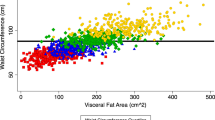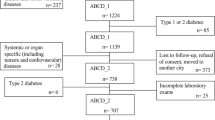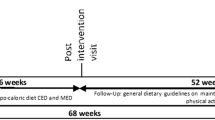Abstract
OBJECTIVE: To identify contrasts between the risk factors associated with abdominal weight gain and those associated with peripheral weight gain. DESIGN: Prospective mail survey. SUBJECTS: 44 080 white, non-Hispanic, healthy women who were questioned in 1982 (baseline age 40–54 y) and 1992 about weight, diet, alcohol use, smoking, 10 physical activities and other variables. MEASUREMENTS: Self reports in 1992 identified 4261 women who gained weight in the abdomen and 7440 women who gained in the periphery (sites other than the abdomen). Using identical logistic models adjusted for age, baseline body mass index (BMI) and numerous covariates, the abdominal-gain group and the peripheral-gain group were separately compared with 10 888 women who did not gain weight. RESULTS: The likelihood of abdominal gain exceeded that of peripheral gain (by comparison of estimated odds ratios, abdominal vs peripheral) for high meat eaters (1.50 vs 1.15), frequent users of liquor (1.09 vs 0.54), moderate cigarette smokers (0.86 vs 0.59), heavy cigarette smokers (0.96 vs 0.36), cigarette quitters (2.13 vs 1.63), women with high parity (1.52 vs 1.15) and those who reported major weight gain since age 18 y (1.22 vs 0.65). Abdominal gain was less likely than peripheral gain for high vegetable eaters (0.71 vs 0.91), women who exercised ≥4 h/wk [(especially aerobics/calisthenics (0.28 vs 0.91) or walking (0.84 vs 1.06)], women who completed menopause (0.74 vs 0.98) and consistent users of estrogen replacement therapy (0.93 vs 1.22). CONCLUSION: A behavior or characteristic may be associated differently with the risks of abdominal and peripheral weight gain. This insight could strengthen recommendations for preventing major chronic diseases.
This is a preview of subscription content, access via your institution
Access options
Subscribe to this journal
Receive 12 print issues and online access
$259.00 per year
only $21.58 per issue
Buy this article
- Purchase on Springer Link
- Instant access to full article PDF
Prices may be subject to local taxes which are calculated during checkout
Similar content being viewed by others
Author information
Authors and Affiliations
Rights and permissions
About this article
Cite this article
Kahn, H., Tatham, L. & Jr, C. Contrasting factors associated with abdominal and peripheral weight gain among adult women. Int J Obes 21, 903–911 (1997). https://doi.org/10.1038/sj.ijo.0800490
Received:
Revised:
Accepted:
Issue Date:
DOI: https://doi.org/10.1038/sj.ijo.0800490
Keywords
This article is cited by
-
Beer consumption and the ‘beer belly’: scientific basis or common belief?
European Journal of Clinical Nutrition (2009)
-
Meat consumption and the risk of type 2 diabetes: a systematic review and meta-analysis of cohort studies
Diabetologia (2009)
-
Dietary factors associated with obesity indicators and level of sports participation in Flemish adults: a cross-sectional study
Nutrition Journal (2007)
-
Reported food intake and distribution of body fat: a repeated cross-sectional study
Nutrition Journal (2006)
-
Alcohol Consumption in the Severely Obese: Relationship with the Metabolic Syndrome
Obesity Research (2002)



